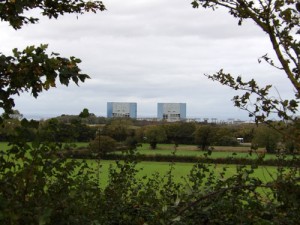
The decommissioned Hinkley Point A nuclear power station in its rural Somerset setting.
Image: Adrian Flint
With its agro-pastoral landscape of hedgerows, fields, and rolling hills and levels, often-sleepy Somerset may be the very picture of rural England – the quintessential ‘green and pleasant land’. To reinforce this, the area gained a variety of landscape and environmental designations over the course of the twentieth century, including Exmoor National Park and the Quantock, Mendip and Blackdown Hills Areas of Outstanding Natural Beauty (AONBs).
At the same time the Somerset region is a twenty-first-century hub of energy production that faces further intense energy development, both renewable and non-renewable. It is the site of the Hinkley Point nuclear power stations A and B, and, potentially C, as well as new supersized transmitter pylons. It is also increasingly – often controversially – dotted with wind- and solar-power projects.
To what extent are the two faces of Somerset in conflict with one another? After all, Somerset has a long, proud record of historical energy provision, if its coal mining and other industrial activities are taken into account. How is it that inconsistencies between public expectations of landscape beauty and energy security have developed?
As a historian of the Universities of Bristol and Cambridge, Jill Payne has worked on the historical dichotomy between energy provision and the aesthetics of landscape and environmental protection in South West England. In this episode of the Exploring Environmental History Podcast series, Jill explores what people have come to expect in terms of energy security and how this squares with the issues involved in the desire to protect and preserve landscape and environment in ‘green and pleasant’ England.
Further reading and resources
Jill Paynes blog posts on the Power and the Water website.
Quantock Hills blog posts on the Histories of Environmental Change website.
Luckin, Bill, Questions of Power: Electricity and Environment in Inter-War Britain (Manchester University Press: Manchester, 1990).
Nye, David E, American Technological Sublime (MIT Press: Cambridge, Massachussetts, 1994).
Williams-Ellis, Clough, England and the Octopus (Geoffrey Bles: London, 1928).
Music credits
“Marcos Theme” by Loveshadow, available from ccMixter
“Out in the rain” by offlinebouncer, available from ccMixter



February 24, 2016 at 8:58 pm
Thanks very much, Jill and Jan, for encouraging us to ruminate on the distinction between ‘the industrial’ and the ‘the rural’ – particularly our expectation of a clear separation between them – and to think about how we often don’t want to see what we need. Why do we find it easier to overlook a landscape of intensively farmed fields (a site of agro-industrial production that Carey McWilliams, in the context of the emergence of corporate farming in California, referred to in 1939 as ‘factories in the field’) than to overlook a site of energy production such as Hinkley Point? Does it, as Jill suggests, have a lot to do with the concentrated nature of a nuclear plant’s physical imprint, whereas the footprint of agro-industry is all over the place and therefore, paradoxically, stands out less?
The nuclear feature that somewhat overshadowed my boyhood landscape was Sellafield, known back then as Windscale, on the Cumbrian coast. You couldn’t actually see it looking due north from the beach in southwest Lancashire, whereas Blackpool Tower looked close enough to touch and, on a clear winter’s day, the snow-capped heights of the Lakeland fells were wonderfully luminescent. But reckless as we were in many other respects, we (us?) local lads completely ruled out swimming; not even paddling was considered safe. Who wanted glowing feet at the school disco?
For most visitors to the Lake District, though, Sellafield/Windscale was conveniently tucked away in a corner, geographically close but remote from, even non-existent within, their mental landscapes. You didn’t have to pass it on the way there, whether you arrived from the south, as most visitors did, or came down from the north.
The situation is different, I feel, in Jill’s southwest England. Unless it’s a particularly misty or dull day, it’s hard to visually erase the structures of Hinkley if you’re travelling to the northern side of the Quantocks or beyond to Exmoor from Bristol or from points further to the north or from an easterly direction. Unless, that is, like Bryan Little, author of Portrait of Somerset (1969), you think they look ‘for all the world like the twin keep of some great Norman castle’. Is Little’s evaluation a spectacular example of de-abnormalization? A colossal example of aestheticization?